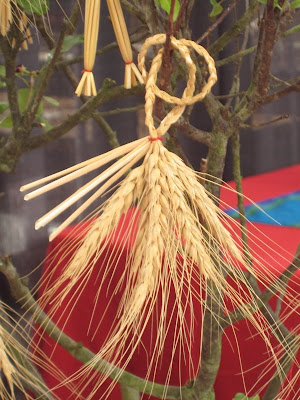Here's my set-up: wheat that has been soaking in water, a pan & wet towel to keep the straw wet, buttonhole thread, scissors, a ruler, an instruction book, and my samples. You also need a spray bottle to keep the wheat damp as you work. The unused wheat stays covered with a towel. It is helpful to cut a bunch of lengths of thread ahead of time.
 The first and most important thing you learn is the clove hitch, the knot which is the basis for wheat weaving. Hopefully it is correct in this photo:
The first and most important thing you learn is the clove hitch, the knot which is the basis for wheat weaving. Hopefully it is correct in this photo: The first thing you make is the angel's wings, using four 4" lengths of straw. Tie a clove hitch around the straws, move it to the center, and pull it tight, then make an overhand knot, and trim the ends. Set the wings aside back under the damp towel. (Eight straws also make very nice wings, but stick to four if you are making a man.)
The first thing you make is the angel's wings, using four 4" lengths of straw. Tie a clove hitch around the straws, move it to the center, and pull it tight, then make an overhand knot, and trim the ends. Set the wings aside back under the damp towel. (Eight straws also make very nice wings, but stick to four if you are making a man.) Next, make the body. Cut eight 8" lengths of straw. Tie a clove hitch around them, move it to the middle, pull tight, tie another knot, and leave the tails, they will become a hanger. Fold the straws in half, then tie another clove hitch to form the head. Tie another knot, and trim it.
Next, make the body. Cut eight 8" lengths of straw. Tie a clove hitch around them, move it to the middle, pull tight, tie another knot, and leave the tails, they will become a hanger. Fold the straws in half, then tie another clove hitch to form the head. Tie another knot, and trim it. Next, separate the straws to make a front and back of eight straws. Put the wings in between the two groups. Push them up tight to the head. Tie a clove hitch around all the straws below the wings, and push it up tight. Make another knot and clip the ends.
Next, separate the straws to make a front and back of eight straws. Put the wings in between the two groups. Push them up tight to the head. Tie a clove hitch around all the straws below the wings, and push it up tight. Make another knot and clip the ends. Finally, tie the two strands at the top together for the hanger, and trim the ends of the straws. Cut them at an angle. You can make the wings and the skirt flare by cutting different lengths. I also just gathered all the straws in the skirt together and cut straight across, it looks nice, too.
Finally, tie the two strands at the top together for the hanger, and trim the ends of the straws. Cut them at an angle. You can make the wings and the skirt flare by cutting different lengths. I also just gathered all the straws in the skirt together and cut straight across, it looks nice, too.
To make a man instead of an angel, simply separate the straws into "legs" of eight straws and tie.
 The heads were so beautiful, I didn't want to waste them. I made some love knots which are just braided lengths knotted and tied together.
The heads were so beautiful, I didn't want to waste them. I made some love knots which are just braided lengths knotted and tied together.
2 comments:
Those pioneers on the lone prairies knew how to create beauty with the simple things at hand. Do you know where the craft originated? Thanks for sharing this technique.
The book I'm looking at, "The Book of Wheat Weaving and Straw Craft" by M.G. Owens-Celli has a good intro about the history. Perhaps the ancient Egyptians did wheat weaving as bundles were found. The Greeks & Romans made wheat items to celebrate the associated goddesses, Demeter & Ceres.
Essentially, any group that cultivated wheat also wove it. The Romans spread wheat cultivation throughout Europe, so it is widespread. It's ritual aspects have diminished, but it is still a popular folk craft. The book has designs from North Africa, Lithuania, Ireland, Poland, Pennsylvania, and more.
Post a Comment